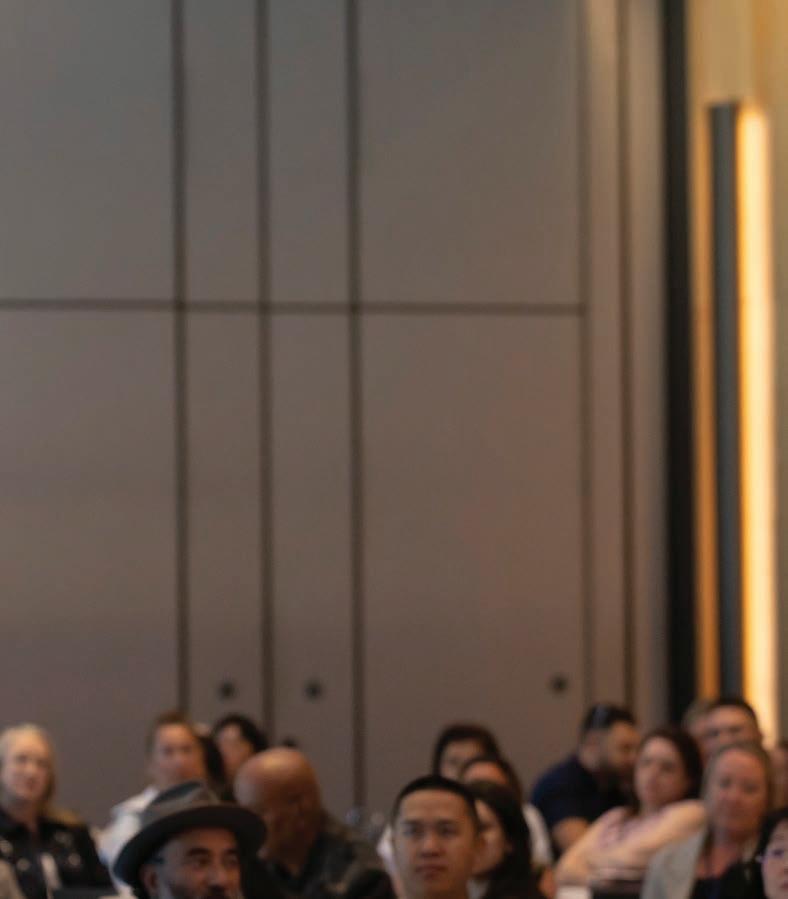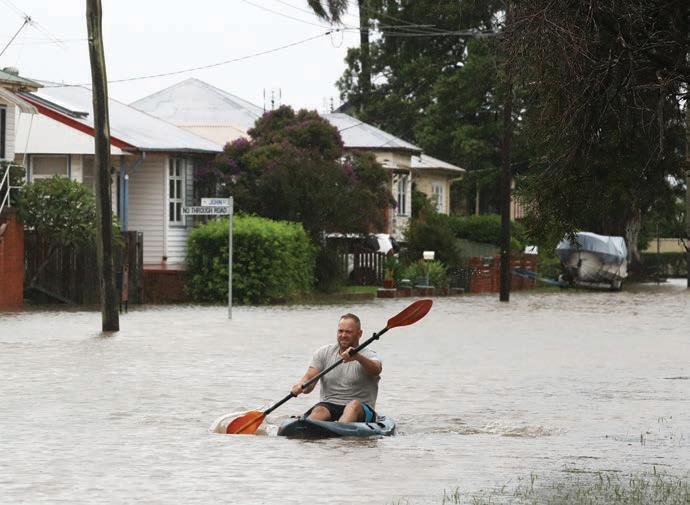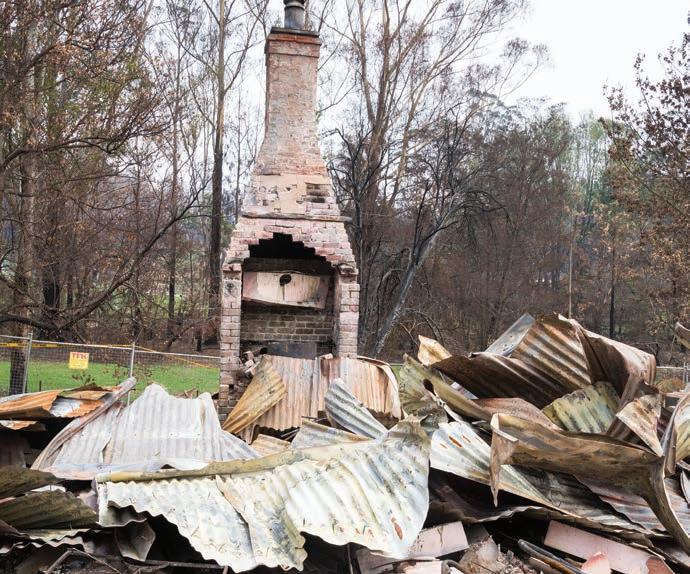

NICOLE BENNETTS: City planning expert AIM HIGH
Feedback
Australian Conveyancer welcomes feedback about any aspect of its activities and appreciates suggestions for future editorial coverage.
Contact the team: editorial@australianconveyancer.com.au
Contact the publisher: tony.gillies@australianconveyancer.com.au +61 414 320 487
LinkedIn: linkedin.com/australiancoveyancer
What does Powered by triSearch really mean?
Australian Conveyancer strenuously preserves its editorial independence. We engage experienced editors, journalists and freelancers not afraid to ask the difficult questions and report without fear or favour. Our editorial charter of independence is formulated in the spirit of balance, fairness and accuracy. We think we owe that to the industry.
The involvement of triSearch allows this privilege by providing the resources needed – the financial and technical infrastructure. It does not expect or receive editorial favouritism in return. If it matters to the industry and if it promotes a constructive conversation, then we will report it.
Advertising
Australian Conveyancer incorporates paid advertising in its publication and other media entities as a part of its business model. Advertisements from all parts of the sector are welcomed into this environment. Advertising and editorial in this publication are separate functions, meaning an advertiser is not given preferential editorial considerations because it has a separate commercial arrangement. Editorial content is treated solely on news value and public interest.

Scan QR code for FREE delivery of printed copy, digital access and newsletters australianconveyancer.com.au
The sky’s the limit
THE natural beauty of Sydney is arguably its greatest asset: the beaches, bays and rivers, national parks and mountains. The city’s 5.6 million people are sprinkled in and around these landmarks that span almost 12,500 square kilometres.
Sydneysiders like their space. An average of 440 people inhabit each square kilometre. The flipside of wide-open spaces is long commute times and costly infrastructure to help get you from Point A to B.
In the equally beautiful city of Melbourne (population 5.3 million), some 536 people occupy each square kilometre. Australia’s population (27.5 million) is growing at a rate of 1.6 per cent (about 420,000 per year).
So, we have a couple of things bearing down on us. Housing is in short supply; what is available is getting harder for many to afford; and we have a race on to build 1.2 million homes by 2029. There are tracts of land beyond city outskirts, but the cost and practicality are a hard case to prosecute.
Futurists and city planners say we need to reset our thinking on housing development; the answer is building up, not out. Get people closer together and closer to amenities, they say. And we cover that off in our special report in this issue. But the concepts might be hard for some to embrace. Do we risk losing the charm and character that makes our cities what they are?
Towers that look like Lego blocks for as far as the eye can see would be difficult to contemplate.
Perhaps there’s something to take in from other desirable global cities: London: 5,664 people/sq km
New York City: 11,313 people/sq km
Paris: 19,400 people/sq km
The common themes: a balance of attractive lower rise building, common garden spaces and parklands.
In this edition of the Australian Conveyancer and in the coming months, we’ll keep the dialogue going. We’d all love to the see the housing crisis ease but we don’t want to give up our heart and soul in the process.

Tony Gillies, Publisher

Tony Gillies Publisher
tony.gillies@australianconveyancer.com.au


Copyright
Richard
Cunningham Associate Editor
richard.cunningham@australianconveyancer.com.au
James
Dore Marketing Manager
james.dore@australianconveyancer.com.au
Contributors:
WORDS
Sam McKeith
Business journalist for 17 years
Leigh Reinhold Business owner and journalist for 40 years
Lewis Panther News and business journalist with over 30 years’ experience in the UK and Australia
IMAGES
Neil Bennett
Senior photographer and manager with 36 years’ experience
Julian Andrews
Award-winning photographer for 31 years
Helen Orr
Multi-award-winning photojournalist with 17 years’ experience in news and feature photography
Australian Associated Press
National provider of images
Operators on high alert for new compliance burdens
Significant changes are coming for Australia’s anti-money laundering and counter-terrorism financing legislation
The case for pushing up, not out to fix housing supply
High-density, high-reaching buildings in well-located areas offer an affordable and sustainable solution
Industry upheaval marks ‘reset’ opportunity
Regulatory overhaul an ideal time for conveyancers to look at charging what they’re worth, says a business expert
Pressure builds after ‘sharp rise’ in insurance premiums
Some NSW conveyancers are struggling to stay afloat under the weight of rising professional indemnity insurance costs
The property lawyer who drives business through social media
We speak to Empire Legal’s George Sourris on the power of social media
How New Zealand is handling the new AML/CTF regime
We look at how our contemporaries across the Tasman have coped
Moving the dial
Game-changing words and numbers that impacted the industry this month
The impact of climate change
As the world heats up, homeowners face increased challenges due to extreme weather
Western Sydney ‘aerotropolis’ to fuel house price growth
A leading real estate expert expects Sydney’s new airport to give house prices a boost in the city’s west
Compliance burdens put operators on high alert
By LEIGH REINHOLD
Photos HELEN ORR
Significant changes are coming for Australia’s anti-money laundering and counter-terrorism financing legislation, with conveyancers soon to be among the entities responsible for reporting
THE President of the AIC (NT) Sue Carmody is forecasting a “traumatic” time ahead for conveyancers with the introduction of the Anti-Money Laundering and Counter-Terrorism Financing Act.
A concerned Carmody says the extra AML/CTF compliance burdens – including the legal requirement for conveyancers to report suspicious activity – will create real stress when the Act comes into effect in mid-2026.
“The AML is traumatic in terms of what the government is trying to achieve in such a small window of time and making us small operators responsible,” says Carmody, who adds conveyancers are already being threatened with fines for non-compliance, when the rules and guidelines haven’t yet been fully explained.
“We are having our NT conference in October and we’re hoping to have somebody come along and actually speak to us about it.
“We’ve been passing emails out to our members to go online and do the training

“The AML is traumatic in terms of what the government is trying to achieve in such a small window of time and making us small operators responsible.”
– Sue Carmody


sessions, and we’re waiting for the starter kits because most of us are one-man bands, so the starter kit is probably the way that we are going to go with it.
“But this has just added another layer on top of another layer on top of another layer with all the compliances that the government is now putting back on the private sector.
“The sad part of it is that the government does not understand the situation and how people are running their businesses.
“They lump everyone from a one-man band to businesses with 50 employees into the same boat.
“They expect the one-man bands to have a compliance officer to oversee the AML, when many of us simply have to be our own compliance officers.”
Also worrying Carmody are the ramifications conveyancers could face when complying with the AML/CTF Act.
“We will have to know where a client is getting the money from to fund a house purchase,” says Carmody, who believes conveyancers are being utilised as “unpaid Government employees”.
“That’s now our role and we actually have to, how would you say, be the police and dob people in if something’s suspicious.
“Yet, on the flip side of that coin, there’s nowhere in the Act that says we are
going to protect you if, all of a sudden, you’re dealing with somebody that is buying something fraudulently through a gang or the mafia or something illegal.
“I can’t see anywhere in that legislation that says, we’re going to protect you [the conveyancer], if you dob them in.”
Carmody says her misgivings about the AML/CTF are more likely to affect conveyancers working “down south” than the 34 conveyancers operating in the Top End, who are currently more anxious for the long-time-coming rollout of PEXA.
“PEXA is on board in the NT as of this year,” she says, “so everyone’s quite excited about that, but not really that excited yet because it doesn’t affect us in the transaction chain yet.
“This year’s all about mortgage releases and then comes caveats followed by us in the last run, which is August, for the transfers and discharges.”
Carmody says the eventual full implementation of PEXA will ease the current stresses being experienced by Northern Territory conveyancers trying to settle properties while the banks stall on providing timely bank cheques to facilitate the settlements.
“The ongoing issue for us is the banks not turning up on time with bank cheques and delaying settlements,” says Carmody,
“The sad part of it is that the government does not understand the situation and how people are
running their businesses. They lump everyone from a one-man band to businesses with 50 employees into the same boat.
They
expect the one-man bands
to have a compliance officer to oversee the AML, when many of us simply have to be our own compliance officers.”
– Sue Carmody
who believes the banks want to abolish bank cheques in Australia.
“The problem is we aren’t fully serviced on e-conveyancing in the NT yet so we need bank cheques. Trying to make things difficult for us on the ground doesn’t really solve anything.
“It used to be that settlements would start at 11am and that way it gave the land titles office staff plenty of time to process everything in a reasonable timeframe. Now the banks or their agents aren’t turning up down at settlements until sometimes 2.30pm and settlements finish at 4pm. And we could have 50 or 60 settlements to complete.
“Now everyone’s pushed to the limit to try and get all the conveyances across the line in an hour.”
While Carmody says e-conveyancing will help solve the bank cheque problem, she can envisage another challenge for Top End conveyancers, currently working in the country’s fastest growing capital city, with 10.4% growth in the past year and a median house price of $630,000.
“With e-conveyancing coming in, we may well get inundated with conveyancers from interstate wanting to come up here and work,” she says. “Which is just going to cause another layer of stress for the conveyancers already working here.”


trisearch.com.au
AIMING HIGH PUSHING UP NOT OUT
By RICHARD CUNNINGHAM
The sky’s the limit for city centres. City planners and politicians say high-density, high-reaching housing offers an affordable and sustainable solution by creating more supply in well-located areas
BUILD up, not out: a mantra that’s been around for some time but lately gathering pace and heading skyward like a SpaceX rocket.
City planners and politicians say the urban sprawl seen around most Australian cities is no longer affordable, nor sustainable.
We need high-rise buildings in key centres, on major transport hubs and in Central Business Districts where thousands work by day but go home to the suburbs at night.
“It’s crazy that downtown Sydney has fewer than 30,000 people living in it,” says Business Sydney executive director Paul Nicolaou.
“Our city could easily support a residential population of 200,000. Cities such as New York, London and Paris have done this for generations.”
As noted, it’s not a new idea, but long resisted by NIMBYs and those who dream of a single-family home on a quarter-acre block.
High migration and housing shortages mean our capitals can no longer afford that luxury. The


government wants 1.2 million new homes within five years.
Queensland alone anticipates that by 2050, it will have a population of around 11.7 million, double the current number.
Around half are expected to be migrants, with 80-90 per cent concentrated in the southeast.
“It’s a hell of a lot of growth in a fairly small area,” says Nicole Bennetts, national head of advocacy for the Planning Institute Australia.
She sees many being accommodated in medium to high-density housing, because unlimited urban sprawl is unsustainable.
And unaffordable: extending infrastructure to new free-standing homes adds an estimated $70,000 to each.
“That’s a big difference,” Bennetts says, “and among the biggest drivers for why we have to accommodate the right homes in our existing areas.”
City skyscrapers are one option, along with inner-suburban medium-density development.
But all need that vital infrastructure:
transport, parks, shops, medical and education facilities, including “vertical schools” in CBDs.
“Public transport is key,” Bennetts adds. “Bus and rail services, and also active transport: cycleways and footpaths.”
Luke Whistler, Deputy Chair of the Infrastructure Association of Queensland,
agrees that growth needs to be focused in established, well-connected areas.
“This allows us to upgrade existing infrastructure rather than undertaking the immense cost and resource burden of extending services into the fringes,” he says.
Whistler believes a co-ordinated approach to development and infrastructure will “future proof” our cities.
“It will ensure we create resilient and connected communities that are fundamentally more liveable for a growing population,” he says.
“This
allows us to upgrade existing infrastructure rather than undertaking the immense cost and resource burden of extending services into the fringes.”
– Luke Whistler
Whistler names Brisbane’s Stones Corner, a designated renewal zone just 4km from the CBD, as a great example of an old neighbourhood on the up-and-up.
Plans for high-rise housing, especially in those middle-distance suburbs, often bring a knee-jerk negative response.
But Bennetts feels that attitude is changing, especially among migrants and millennials.
“They don’t want to live on the outskirts of town,” she says. “They want a more compact environment and not have

Luke Whistler, Deputy Chair of the Infrastructure Association of Queensland.
CONVEYANCERS
BEWARE: Pitfalls of high-rise dwellings
CONVEYANCERS are being warned that high-rise dwellings could present big legal challenges for them, and their clients.
The issue is that many residential skyscrapers are mixed use and mixed tenure, with apartments for sale or rent, plus shops and office space with differing strata laws.
Property law expert Cathy Sherry from Macquarie University says Sydney’s Wentworth Point, 12km west of the city, is a prime example.
Professor Sherry says the suburb, built on former industrial land, was part of multiple strata schemes inside multiple community schemes inside an overarching strata subdivision.
“It is incredibly complex,” she told a recent AICNSW state conference. “The sales contracts for an apartment at Wentworth Point are 680 pages long.”
One apartment could be regulated by “29 pages of strata by-laws, 47 pages of community management statement and 110 pages of a strata management statement.”
“It’s 187 pages of privately written rules that you and your clients should have read,” she said.
“When we’re talking about undercharging for conveyancing this is the kind of thing that’s going to take an enormous amount of time.”
For example, by-laws might prohibit children from rollerblading or skateboarding on common property.
“That’s because it’s privately owned property and under the legislation the owners are compelled to have insurance,” Prof Sherry explained.
to mow lawns on the weekend. That Great Australian Dream is changing.”
Adelaide has embraced upward mobility as it plans for 50,000 extra people by 2036.
“Adelaide, like all Australian capitals, is going up,” Lord Mayor Dr Jane LomaxSmith told AC. “As a council we support this growth in high-rise living.”
Affordable housing is a key part of

Adelaide’s mix. And the city has dedicated funding to promote re-use of vacant commercial or “stranded assets” for residential use.
City living offers significant economic benefits. If you live in the city, you’ll likely work and socialise there, too: creating more jobs, wealth and spending.
“It’s all about having people in close proximity that creates that urban agglomeration benefit,” Bennetts adds.
In other words, the city becomes an engine of productivity.
“We keep looking for the ‘secret sauce’ when the recipe for economic growth is obvious,” says Business Sydney’s Paul Nicolaou. “People make the difference.”
New single-family homes surrounded by lawns and trees will still be available, but they could become increasingly expensive and isolated.
Planners speak of a 70/30 rule, where 70% will be infill development, just 30% on greenfield sites.
A notion backed by the Government’s National Urban Policy, which notes that
nearly 80% of the population now lives in our 20 largest cities.
“Our inner-city rings are characterised by higher population density and high access to employment, services, infrastructure, public transport and amenities,” it states.
“Middle-city rings typically have lower density than inner-city areas but often have high-density precincts around public transport hubs.
“Outer-city rings represent suburban Australia, typically including established and greenfield urban suburbs, and surrounding rural areas. As our cities grow, middle and outer-city rings often experience stresses on infrastructure.”
The consensus is that more high-density – and high-reaching – housing is inevitable.
With good planning and regulation, it should be more affordable, and more sustainable.
It could also prove an economic bonanza for conveyancers, with at least one of Sydney’s planned new skyscrapers having some 1,500 apartments.

Adelaide Lord Mayor Dr Jane Lomax-Smith.

HIGH-RISE HOTSPOTS
Planning is proceeding for Bays West, near White Bay power station, just 2km west of the Sydney CBD, with a new Metro station to open there by 2032. Building heights are slated to be up to 25 storeys.
The State Government is also planning to use a former Metro dive site in Chatswood’s CBD for up to 1,500 new homes, including 180 buildto-rent apartments. Plans are yet to be finalised, but artists’ impressions indicate towers of at least 40 storeys.
Homes Victoria is redeveloping 44 public housing towers across the inner city.
There are also plans for high-rise residential and office towers near 50 public transport hubs or “activity centres,” with heights of up to 20 storeys.
Among the core areas are Hawthorn, Oakleigh and North and Middle Brighton.
The 2032 Olympic city aims to build 210,000 homes in the next 25 years, with areas such as inner southern Stones Corner earmarked for 2,000 new dwellings by 2046, an increase of about 1,200.
Other renewal plans are underway further south at Mt Gravatt, the northern suburb of Alderley, and bayside Wynnum.
SYDNEY
MELBOURNE
BRISBANE

ADELAIDE
Adelaide has more than 30 major projects worth more than $10 billion planned, approved or under construction. The tallest include Festival Tower Two at 38 storeys and Keystone Tower at 37 storeys.
They are commercial or hotel developments, but there are plenty of high-rise apartments, too. They include the 122-metre Victoria Tower on Grote Street, with 285 apartments, and Tapangka on Franklin St, with 392 apartments.
PERTH
Our western capital hasn’t had to be told to build up, already boasting 30 buildings at 100 metres or more, with five exceeding 150 metres.
Residential towers include Civic Heart and The Towers at Elizabeth Quay, with riverfront Burswood Point and Garden Towers under construction.
DARWIN
Darwin has several residential towers, with the tallest being the 33-storey Evolution on Gardiner, completed in 2008.
There are also Mantra Pandanas (29 floors), Soho Apartments (28) and Skytower Apartments (21). Others are underway or in planning.
HOBART
Hobart is not exactly a high-rise hub. Locals are very protective of their historic cityscape, with modest height limits.
Among its tallest residential buildings are the University of Tasmania’s student accommodation (15 storeys) and Empress Towers (12 storeys).
Wrest Point Casino Tower, a few kilometres away at Sandy Point, opened in 1973 and remains Tasmania’s tallest at 19 storeys or 73 metres.

NOW IS THE TIME TO RESET: INDUSTRY UPHEAVAL SHINES LIGHT ON NEW OPPORTUNITY
By SAM McKEITH
A looming regulatory overhaul of the conveyancing industry marks an opportunity for firms to recalibrate operations and prices, a small business expert says
ASMALL business expert says regulatory changes set to hit the conveyancing industry should be seen not as a major burden, but as a chance to revamp pricing and business practices.
That’s the message from Andrew Griffiths, a leading small business author, who urges conveyancers to shift their mindset when thinking about the impact of Australia’s new Anti-Money Laundering and Counter-Terrorism Financing (AML/CTF) laws on the industry.

Conveyancers face a big few years ahead with the sweeping national laws –bringing the country into line with most other nations – set to take effect in 2026.
Australia’s financial crime regulator has warned it will not hesitate to pursue businesses that breach the laws, which some conveyancers claim add undue compliance costs and time.
Addressing the AIC NSW state conference 2025, Griffiths put a different spin on the changes, saying they were for conveyancers “an opportunity you have on your doorstep”.
“Next July, AML CTF, what if that at the moment is ‘Oh my god’, but what if that is the greatest opportunity your industry has for finally resetting prices,” he said.
“What if that is the greatest opportunity your industry has for doing a complete reset. What if that is the greatest opportunity for you to do a complete reset about your business, because I believe that it is.”
He said the regulatory overhaul was an
ideal time for conveyancers to take a look at charging what they’re worth and putting their prices up, personal branding, creating more word of mouth referrals, and redefining their value.
“Personally, you’ve got a great opportunity coming up next year to do exactly that, all of that, particularly putting up your prices,” Griffiths said.
Even so, he conceded that it can often be difficult for business owners to cope when there was a lot of change, upheaval and disruption going on around them.
At such times, part of the solution was to differentiate between the factors a conveyancer can control and those outside of control, the Tasmania-based expert said.
“We’ve got to go, ‘Right, what can I control? What can’t I control? Where am I wasting my energy? What impact is that really going to have’,” he said.
To action this, Griffiths recommended conveyancers itemise tasks they spend a lot of time and energy on then put them in
Author and small business expert and adviser Andrew Griffiths.
“What if that is the greatest opportunity your industry has for doing a complete reset. What if that is the greatest opportunity for you to do a complete reset about your business, because I believe that it is.”
– Andrew Griffiths
either an ‘I can control’ or ‘I can’t control’ list. “I can control elements of my business that I want to change, that I want to develop, my health and wellbeing, I can get fit and can do what I need to do to recover,” he said.
Another tactic to “stay sane” at the moment, he said, was to seek out high quality information and media, and limit the flow of unreliable content. This was especially important in the current business landscape where “there is so much information available to our brains”.
“We’re putting so much time into stuff that isn’t true – checking your sources, checking where you’re getting your information from. But also, really limiting the amount of information,” Griffiths said.
“I think there is something uniquely beautiful in limiting that, disconnecting, turning off, being more selective about what we let into our brain – limit the voices that are out there and are going to distract us.”


FEELING the PINCH of INSURANCE COSTS PREMIUM PRESSURE
By SAM McKEITH

Some NSW conveyancers are struggling to stay afloat under the weight of increasing professional indemnity insurance costs, according to industry participants
CONVEYANCERS in Australia’s largest state are feeling the impacts of rising professional indemnity insurance costs, prompting some to consider exiting the industry.
That’s the message from Sydney property lawyer Nour Salama, principal of Salbridge Lawyers, a firm that specialises in property and leasing, including conveyancing services.
Salama says there’s been a big lift in PII costs in recent times, attributing it to a lift in risk flowing from things such as cyber threats, potential non-compliance with new anti-money laundering laws, and strict regulatory oversight on recent surcharge purchaser duty rules.
The rising cost of PII is a popular topic online among NSW conveyancers, she says. “Every second post is a complaint about all the fees going up,” she says.
“I practice in other areas of law but for conveyancers who practice exclusively in that, it’s becoming not even worth it sometimes.
“It’s definitely been a lot more of an issue in recent times, maybe more with cybersecurity and the cyber threats and all these new compliance issues that have been raised recently,” Salama says, pointing to the country’s recent “tranche 2” reforms.
The recent overhaul expanded the country’s anti-money laundering and counter terrorism financing (AML/CTF) system to “high-risk services” provided by real estate professionals like conveyancers. AUSTRAC has warned conveyancers to comply with the tough new laws, warning it aims to pursue businesses that breach the rules, legislated this year.
On cyber risks, she says conveyancers are prime targets of cybercriminals given the “very high value transactions” handled by the profession, contributing to PII premiums going up.
“I’ve seen it first-hand,” she says,
recalling an instance where a client received a “purported email from me saying to transfer the purchase balance” to an unknown account.
“The client said, ‘You’ve already given me your account details. Why are you sending them to me again?’ and forwarded me the email and I said, ‘This wasn’t from me’. It happens a lot.”
AIC NSW CEO Chris Tyler echoes the property lawyer’s comments, saying insurance costs have risen sharply in the past few years, hitting small firms especially hard.
“Any increase in cost puts small business operators under pressure,” Tyler says, blaming foreign resident surcharge purchaser duty claims for the uplift.
“You need to increase your fees, focus on process and procedures and risk management to minimise any claims or potential exposure to claims,” he advises NSW conveyancers.
He also wants action from state authorities on the issue, urging them to review and redesign their processes to redirect risk to the taxpayer.
“Too often insurance claims are being experienced on transactions which are more than five years old,” he says.
“Revenue NSW has the capacity to conduct compliance audits on those and when these audits disclose incorrect assessments the taxpayer is directed to the conveyancer to make a claim.”
Tyler disputes the merits of Revenue NSW chasing up old claims. “The claims incur significant dollar penalties and extraordinary amounts of interest – 11.78% accruing daily – considering they are for transactions that are many years past,” he says.
“Prior to electronic conveyancing these errors were incurred within RNSW offices and were not a drain on the Professional Indemnity Insurance master scheme,” he adds.
“Every second post is a complaint about all the fees going up. I practice in other areas of law but for conveyancers who practice exclusively in that, it’s becoming not even worth it sometimes.”
– Nour Salama (right)
By contrast, AIC Victoria CEO Shakila Maclean paints a positive picture in her state. She says some PII costs remain steady while others have fallen in Victoria for 2025/26.
The upbeat result follows much “time and effort into delivering a tailored, risk-management-focused CPD program for our members”, Maclean says.
“The results are clear: we’re seeing a real shift towards a less claims-based approach, showing the program’s impact on both professional standards and better outcomes for consumers,” she says.
“This shows the program’s impact in strengthening professional standards and improving consumer protection, while also reducing costs and risks across the industry.
“Participation in CPD has grown yearon-year, with more members embedding risk-aware processes into everyday practice.”
Katy Send, of Melbourne-based Anchor Conveyancing, says PII is a significant cost burden on the conveyancing firm and one of its largest expense items.
But after steep increases in premiums in the years after the state implemented electronic settlements, Send says it’s pleasing to see premiums headed lower in the state.
In the conveyancer’s opinion, greater reliance on technology has come with increased industry risk, putting upward pressure on PII in the recent past.
“Modern tech made life much easier. For example, electronic settlement is a lot easier to process than a paper settlement. But at the same time, we have put our property industry at significant risk,” she says.
“When government went ahead with introducing electronic settlements it did not account that our banking industry lags behind other countries without a system in place to verify that the name of the money transfer recipient matches their bank account number.”

As Send sees it, the issue of PII premiums ranks as an industry pressure point beneath low quality practitioners pushing fees down, compliance costs and cybersecurity costs. “Premiums will be growing and there is not much extra we can do about it apart from constantly being alert about threats,” she says.
Further north, the Queensland Law Society says its jurisdiction, like Victoria, is not experiencing the same issues as NSW when it comes to PII.
It says in Queensland, where only legal practices do conveyancing and are insured by the QLS-owned Lecon, premiums have “been going down year on year for the past four to five years”.
“There’s no solvency issues in the scheme and little exposure to the volatility of the market,” a spokesperson says.
Nationwide, professional indemnity insurance products have seen similar premium trends to public liability in recent years, according to analysis by the Australian Prudential Regulation Authority, which says the average PII premium has surged by 27% since 2015.
APRA says the increase in average premium is significant for micro businesses at 85%, low for small and medium-sized businesses at up to 10%, and “significant”
for large and corporates at 70-160%. “This indicates that insurance affordability has reduced most for micro and large/corporate businesses,” the agency says.
Twane Wessels, from Bond University’s business school, says in circumstances where PII premiums are going up fast, it’s unlikely to be the result of profiteering by insurers.
“I think that the principles still remain that if we’re seeing increases above what we expect to be normal it’s because of more risks that they are trying to price for,” Wessels says.
“Often people become a little bit angry at insurance companies because they think their premiums are going up because of the profit loading but it’s necessary to understand the foundation of where those pricing increases come from and it’s not necessarily profit.”
She says Australia has “quite a competitive market” for insurance, which should help keep a lid on PII premiums.
It’s also in an insurer’s interest to keep policy holders signed up, she says.
“For an insurance company the bigger your pool of policy holders is the more competitively you can price actually, so they would want to hold on to all their clients that they possibly can so they can still have those economies of scale.”

Soaring insurance costs hitting NSW conveyancers hard
By LEWIS PANTHER
Additional loading fees for some conveyancers mean their business is not viable, says leading practitioner
CONVEYANCERS are facing additional loading to their insurance premiumswith some being hit with increases of 370 per cent. That’s the burden a number of businesses are handling because of the new loading system introduced by their insurer and because of penalties levied by Revenue New South Wales against their clients
Many have had to make claims because of renewed assessments of the Revenue NSW Surcharge Purchaser Duty – as clients have been hit by backdated demands for payment.
The stark reality is that those businesses with massive insurance premiums may not be viable, Your Move Conveyancing owner David Winning tells the Australian Conveyancer
Winning said the problems started with Revenue NSW’s surcharge purchaser duty regime in 2016.
“The surcharge purchaser duty regime was introduced by Revenue NSW to find out about foreign ownership of real estate in Australia,” he said.
“The Federal Government didn’t know who was buying property – and the States didn’t know either. It required the practitioner to collect that information off the consumer in a declaration form.”
A surcharge on the purchase price was introduced, which now sits at 9 per cent of the purchase price, along with the new process, much to the well-documented annoyance of many conveyancers.
“It required almost overnight learning,” Winning said, explaining that under the new rules conveyancers had to collate data from clients to show they were resident in Australia long enough to avoid the surcharge.
“To determine whether they were
“Fast forward a couple of years later and Revenue NSW went on a massive audit which shook the whole legal and conveyancing industries.”
– David Winning (below)

UNOFFICIAL TAX COLLECTORS FOR REVENUE NSW
AS other conveyancers and industry leaders have told the Australian Conveyancer, acting as a quasi-tax collector is one of their big bugbears.
“It’s unfortunate that a large part of a conveyancer’s role is broadly compliance,” says Your Move Conveyancing owner Dave Winning Dave Winning.
“It’s not adding any value to the customer. We’re more or less pinned into somewhat being the bearer of bad news for our clients.
“About 25 per cent of the overall conveyancing transaction is spent on compliance – and that’s conservative.
“We have plenty of clients who we’ll spend over an hour talking through a
ordinarily resident. If they weren’t, then this surcharge would apply. It became very –well, it is still – quite confusing.”
The problems became evident when Revenue NSW began auditing.
“Fast forward a couple of years later and Revenue NSW went on a massive audit which shook the whole legal and conveyancing industries,” said Winning.
“They reissued a whole heap of assessment notices directly.
“Over the past five years, about 45 per cent of the claims made on the Policy were attributed to Surcharge claims.”
Knock-on effect for insurance premiums
With insurance soaring - up 20 per cent and even 40 per cent for some – Winning questions the viability of those hit with additional sky-high loading for making claims over the past nine years.
“How much of a loading depends on the severity of the claim and how frequent your claims were,” he explained.
“The claims loading itself can go up to 420 per cent. You basically become uninsurable at a certain point.
“Once you get into those higher level categories, you’ve got to be questioning your ability to provide quality conveyancing services, let alone the financial burden and viability of running a successful practice.”
Of the 500 conveyancing businesses in NSW, 30 per cent had an increased loading on their insurance premium.

declaration form that might be quite complex.
“We are the collectors of a large pool of revenue for the state and constantly threatened with these audits.
“This compliance burden means we’re the unofficial information and tax collector for several tiers of government and departments.”
By LEWIS PANTHER
MEET the SUCCESSFUL PROPERTY LAWYER who’s a MASTER of SOCIAL MEDIA
WALKING around the prestigious AREC conference three years ago, George Sourris could have been a stranger who had stepped in off the street.
None of the agents or brokers gave the property lawyer a second glance as he walked by the booths looking for leads for the Empire Legal business he runs with his business partner.
Admittedly, George might not have been as recognisable as former US vice president Kamala Harris, who was a keynote speaker at this year’s event.
The 2025 conference was a completely different story from the 2022 gathering, which was held before George’s social media push, with many more agents stopping him to say hello.
“People were coming up to me saying, ‘I’ve seen you, you’re that property lawyer who does the videos’.”
Which is job done for George, who spends his time working on educational content to slather across social media.
With an increasing number of conveyancers seemingly spending an increased amount of time talking about their business, the AC spoke to George to get the inside word on the power of social media.
“I don’t bill one dollar for our firm and haven’t for about probably two years now,” he says.
“My primary role is building relationships with real estate agents and mortgage brokers – and the best way I found to start that journey is through social media.”
The switch to social media came two years ago when his Gold Coast and Brisbane-based firm hired an in-house social media manager full-time.
“That’s really when we saw the rubber hit the road,” added George.
“Before then we were just ad-hoc posting as consistently as we could and doing our best, but in the last 18 months to two years our entire marketing engine has been firing on all cylinders – with a key focus on social media.
“That’s where the consumer attention is. It’s a simple as that. We’re basically a referral business – clients find us from people telling them to use our services.
“As you know, we passionately don’t pay for the business with kickbacks. So we just go to where the attention is – and for real estate agents and mortgage brokers and clients, that’s on social media.
“It’s YouTube or Instagram, wherever people are sitting and scrolling. That’s where the eyeballs are and that’s where we want to be.”
While George admits concrete digital data is hard to pin down in terms of quantifying results, he adds: “If you zoom out and look like year on year, we’re just getting busier and busier – and that comes down to the amount we post.
“We’re posting on all platforms every day, with the heaviest output on YouTube, both in long-form content and shorts.
“The shorts feed into our educational material, which is the long-form content. Then we’ll do a teaser or a snippet on LinkedIn, Instagram and Facebook.”

Google Maps is also a destination for content as there’s a chance it gets picked up by those searching for conveyancing services in Brisbane.
While he doesn’t use it personally, George’s in-house marketer also posts relevant trend content on TikTok.
“A big chunk of my role now is content creation, and our marketer Maddison brings it all to life,” he says.
“The five-minute blog we do every week, which is educational on a fresh new topic, is my main work.
“Writing it, copy editing, making sure it actually adds value to the audience and we’re not just posting for the sake of it.
“It is a lot of work, but I believe it’s the key to building the brand and building trust.
“I’m not sure what it’s like down south, but up here there is nobody else giving out free information to add value to people who want to buy a property or are involved in property in Queensland.
“I think it’s a truly unique angle – the goal truly is to help people.”
The content is designed for professionals in property (real estate agents and mortgage brokers) – giving them awareness on what’s changing with the law, and how

“My primary role is building relationships with real estate agents and mortgage brokers - and the best way I found to start that journey is through social media.”
– George Sourris
GEORGE SOURRIS ON HIS RULES FOR CONVEYANCERS
“IT’S a slow, consistent game. Our business is eight years old and for the first six years we weren’t really diving heavily into socials.
“Build trust, value, don’t ever rip anyone off or do the wrong thing, and in perpetuity you will win.
“You can get the right people on the bus and have good expectations without flogging yourself.
“I’ve got a family. I don’t work after-hours any more. Neither do my team. Our office hours are 9am to 5pm, and we don’t work on the weekend. That doesn’t suit all people, but the ‘right’ professional partners and clients will find you and respect that. The ‘wrong’ ones won’t, and that’s OK because there are different operators out there who work after-hours and on weekends. They will find their people and that’s all good.
“It’s a big market out there. There’s enough pie for everyone to eat.”
it will impact their role in the transaction. It covers staple topics, what’s new, and what’s up and coming – issues like Seller’s Disclosure.
But, as George says, it’s also not too technical so that if a buyer investor or vendor came across the page, they get great value as well.
“We are getting more and more clients contacting us daily for help with their conveyancing, who found us online – be it on Google, social media or via our YouTube videos.”
While an increasing number of content creators are using artificial intelligence, George is not a fan.
His pet hates are stock images and AI-generated content.
“You see an image of moving boxes, and there’s a mum and dad and a dog and a kid. Every business puts those stock images up on their blog posts and social media,” George says.
“Personally, I can’t stand them. Swipe, next! I want to see the real people. That team. The humans in that office. I want to know about them.
“People can spot AI-generated or stock images a mile away. They know when it’s fake.”

Risqué approach to social media raises plenty of eyebrows
Raunchy videos on Flash Conveyancing’s feeds capture the attention of fellow practitioners
FLASH Conveyancing’s risqué social media strategy has raised quite a few eyebrows amongst practitioners.
But the firm’s Julian Silva-Ortiz doesn’t mind. He says that shows it’s working.
“You only have about three seconds to grab someone’s attention before they scroll past,” says the licensed conveyancer.
“Conveyancing and property law simply aren’t topics that can be made entertaining in that short timeframe.
“People don’t go on Instagram or TikTok to find a conveyancer or solicitor. They go there to be entertained. That’s why we decided to create content that is deliberately funny and, at times, a bit risqué.
“Our primary goal is simply to be noticed and to stay top-of-mind with our audience.
“We’re aware that this approach is risky and that it’s not popular with some of our peers in the industry.”
The team posts a new video every weekday, often shooting an entire week’s worth in a single two-hour block.
“The most time-consuming part is the editing,” he says. “Each video can take up to an hour to perfect. We’re not experts, but doing it ourselves gives us complete creative control.”
Despite the high-volume raunchy content that often features the Macquarie University graduate himself, Silva-Ortiz insists Flash Conveyancing is high-end.
“We are very proud when people approach us in person and tell us how much they love our posts,” he says.
“Even if it’s not directly translating into immediate work, it means that Flash Conveyancing is known and that people remember who we are and what we do.”
By RICHARD CUNNINGHAM
HOW NEW ZEALAND IS HANDLING AML/CTF
As we face up to the reality of the upcoming anti-money laundering and counter-terrorism financing regime, it’s worth seeing how our contemporaries across the Tasman – who have been operating under similar rules for the past seven years – have coped with the changes
NEW ZEALAND police tell of a 19-year-old girl who went directly to a seller and offered to buy an Auckland property… for cash.
The seller thought that was a tad unlikely and called her agent, who checked and declared it legitimate.
Even better, the young lady wanted to buy five properties, cash on the barrelhead.
The agent seemed satisfied; police were not. Just one example, they believe, of the estimated NZ$1.35 billion in dirty money laundered (or attempted) in New Zealand each year.
It’s a racket being stamped on by the NZ AML/CFT Act, which has applied to lawyers and conveyancers since 1 July 2018.
The NZ Department of Internal Affairs, which supervises AML for casinos, lawyers, conveyancers, accountants, realtors and betting agencies, tells the AC the sector has adapted well.
“Audits, inspections, and other engagements by DIA indicate good overall compliance,” a spokesperson said.
That may be so, but some practitioners say compliance can have a high price.
“We spent a fortune,” says lawyer Shaun McGivern, who heads the property division at Auckland’s Haigh Lyon Lawyers.
Their initial AML program which began in 2017 included vetting and training for some 45 staff and cost around $17,000, using outside consultants.
However, when factoring their own directors’ time the actual cost would have equated to nearly $30,000.
“We didn’t really know what was involved, given AML at this level was in its infancy, but we wanted to get things right,” says McGivern. “And for that reason, we felt we needed external advice.”
Now the firm employs a full-time compliance manager – at some cost – while staff and clients have become used to the regime.
“It is what it is, the cost is the cost, you can’t avoid it,” says McGivern.
Some long-established customers, though, chafe at being subject to due diligence. “They say, ‘You’ve been our
lawyers for 30 years, handled umpteen property transactions’. But it has to be done.”
Another criticism was an apparent duplication of effort, with the same money sources being checked by financial advisers, banks, realtors and lawyers.
“They (the government) say it’s because there can be laundering done at any stage,” McGivern adds, “and each reporting entity may have only a partial or different view of the same client or transaction.”
There have been successes: such as the Russian seeking to transfer cash from Papua New Guinea for a multi-million-dollar Auckland property.
He turned out to be a PEP or a Politically Exposed Person. The approach was reported, and the Russian disappeared. But the firm’s investigation cost it $8,000.
“We’ll never recover that money,” says McGivern. “But if we’d made a mistake, we’d be the ones in front of the authorities.”
Penalties can be severe: this June an Auckland foreign exchange was fined NZ$1.125 million for failing to report more than $19 million in dodgy transactions.
New Zealand’s DIA now oversees some 6,000 reporting entities. It issues codes of practice for each industry, and there is regular face-to-face education.
Typical classes include free, two-hour “goAML” sessions conducted by the NZ Police Financial Intelligence Unit.
In a YouTube interview, Detective Superintendent Greg Williams of the NZ Police National Organised Crime Group says the aim is to make “know your customer” a natural part of business.
“Who are they?” he asks. “Where are they from? How did they come by their money? Who do they represent?”
Compliance will seem frustrating for some, but there’s a reason for it, he says.
“It’s about protecting our reputation, our way of life, protecting our people,” Williams says.
McGivern agrees: “We have to be seen as a safe place to transact, so you have to go through with it.”


“We didn’t really know what was involved, given AML at this level was in its infancy, but we wanted to get things right.”
– Shaun McGivern
Shaun McGivern heads the property division at Auckland’s Haigh Lyon Lawyers.
Moving the dial
Game-changing words and numbers that impacted the industry this month
The drop in the number of private sector houses commences in the June quarter compared to the March quarter.
6.6%
Down
Up
4.5%
Unemployment
Australia’s unemployment figures jumped to a four-year high from 4.2% in the September Quarter shock

7.8%
Tourist trend
Increase in the number of long-term visitors
“NEXT
JULY, AML/CTF [LAWS CHANGE]; WHAT IF THAT AT THE MOMENT IS ‘OH MY GOD’, BUT WHAT IF THAT COULD BE THE GREATEST OPPORTUNITY YOUR INDUSTRY HAS FOR FINALLY RESETTING PRICES. WHAT IF THAT IS THE GREATEST OPPORTUNITY YOUR INDUSTRY HAS FOR DOING A COMPLETE RESET.”
– Small business expert Andrew Griffiths (pictured left) sees gold amid the anxiety of enforced legislation and responsibility for conveyancers.

“Adelaide, like all Australian capitals, is going up.”
– Lord Mayor Dr Jane Lomax-Smith.
“The economy could be in for something like a re-run of late 2023, when an upside surprise in September quarter inflation was followed by a downside surprise in the December quarter.”
– Westpac Group economist Luci Ellis placing a bet on a mortgage cash rate hold when the RBA meets on Melbourne Cup Day.check to young people wanting the enter the property market.
“It’s a hell of a lot of growth in a fairly small area.”
– Nicole Bennetts, Planning Institute Australia, on doubling Queensland’s population, most in the SE corner.
Up4.3%
Cost of living
Increase in residential rent nationally to September.
“If you’re in that younger cohort, the ratio of your salary to your loan to your mortgages are just out of control, so the ability to get access to that asset class is very difficult.”
– Stake Investments founder and CEO Matt Leibowitz providing a reality check to young people wanting the enter the property market.
Earnings
Average ordinary time earnings
$2,010 per week
“IT’S 187 PAGES OF PRIVATELY WRITTEN RULES THAT YOU AND YOUR CLIENTS SHOULD HAVE READ. WHEN WE’RE TALKING ABOUT UNDERCHARGING FOR CONVEYANCING THIS IS THE KIND OF THING THAT’S GOING TO TAKE AN ENORMOUS AMOUNT OF TIME.”
– Property lawyer Cathy Sherry (pictured right) warning conveyancers of complex strata by-laws that come with high density housing.
61,000
Number of homes short of the 240,000 target required to meeting the Federal Government’s pledge of 1.2 million new homes by 2029
179,000
Construction of 179,000 homes started in 2024/25


$11.8trillion
Value of Australia’s residential real estate, according to homes data analysts Cotality. This is a rise of $678 billion in the past 12 months.
OUR ‘TERRIFYING’ CLIMATE OUTLOOK: WHAT IT MEANS FOR LAWYERS AND CONVEYANCERS
By RICHARD CUNNINGHAM
As the world heats up, homeowners face increased challenges due to extreme weather, rising costs and health risks. From property damage from floods, storms and fires to higher insurance premiums, there’s plenty of issues that professionals will need to consider
‘AWAKE-UP call.” That was Prime Minister Anthony Albanese’s immediate comment on a long-awaited government climate report issued in mid-September.
The National Risk Assessment led by the Australian Climate Service has sobering, even confronting warnings.
It found a million homes could be at “very high risk” from rising sea levels by 2050, and effectively uninsurable.
The report also predicted a loss in property value of $611 billion within 25 years, and $211 billion in lost productivity.
That’s based on a 2-3 degree Celsius increase in global warming. Other threats include: More frequent and severe extreme events such as floods, fires and cyclones.
Heatwaves leading to many more deaths, especially in northern Australia.
Up to 70% of native plants facing conditions outside their climate range, risking species loss and ecosystem collapse.

“Climate hazards will get worse under all plausible futures,” the report noted.
The Climate Council’s CEO found the contents “terrifying,’ the Greens “chilling”.
Bad news for all, in a country where floods, bushfires and coastal erosion have already cost tens of billions of dollars.
The Risk Assessment was released in the same week as updated climate guidelines for property professionals.
The Law Society of NSW noted its advice could “affect the many solicitors who undertake conveyancing work and the home buyers or sellers whom they advise.”
“Climate-related issues can include advising on bushfire or flood risk and the

affordability, or even availability, of insurance,” Law Society President Jennifer Ball added.
Availability of insurance, in turn, could affect the ability to obtain mortgage finance.
The updated guidance suggests lawyers have a duty of care to “meaningfully address” any climate change issues and their consequences.
Mieke Elzer, Property and Commercial Senior Associate at Attwood Marshall lawyers, says flood, fire and heat risks can leave a home unsellable or uninsurable.
“The assumption that property is always safe, always appreciating, is steadily
“The assumption that property is always safe, always appreciating, is steadily being dismantled,” she said. “That reality has legal and ethical consequences.
– Mieke Elzer
being dismantled,” she said. “That reality has legal and ethical consequences.
“Should governments still approve subdivisions on floodplains? What liability attaches when a council looks the other way? And who should bear the cost when one person’s coastal home… becomes a collective financial burden? These are not hypothetical questions. They are playing out now in insurance refusals, lending restrictions, and stranded assets.”
Those who are purely conveyancers don’t appear to have the same responsibility as lawyers, but most would discuss obvious climate risks with clients.
SAFE AS HOUSES?
It’s often said of real estate that they’re not making any more of it. Unfortunately, for many, bad weather is making less of it, especially on the NSW east coast.
Erosion caused by severe storms and king tides has stripped sand, land and homes from several areas, notably Wamberal Beach just north of Sydney.
It’s been subject to dynamic change at least since European settlement. The Aboriginal word Wamberal means “where the sea breaks.”
The 1960s saw significant sand buildup, encouraging development. But in 1974 major storms threatened beachfront properties, with one home damaged.
Two homes were lost in 1978, with more damage in 1995, 2007, 2016, 2020 and again this year.
Many stakeholders are seeking a Terminal Protection Structure or 1.5km vertical seawall, plus sand “nourishment” as required.
The estimated cost is up to $40 million, with annual maintenance of $265,000.
Buying back the properties would cost up to $1 billion. Central Coast Council’s cleanup bill from the 2020 storms was $2.1 million. “The costs are simply unaffordable and unrealistic,” it says.
A 1.3km-wall at Collaroy-South Narrabeen on Sydney’s northern beaches cost owners, the council and state government $25 million. A new seawall at Nielsen Park in Sydney’s Vaucluse cost $20 million.
Other beaches are under threat at Byron Bay in NSW, Fremantle WA, Victoria’s Inverloch, and Post Office Rock near Beachport, SA.
One review found that if global average sea levels rose 1.1 metres, up to 247,600 Australian homes would be at risk.
Sea levels have risen about 20cm in the past 100 years, a rate said to be accelerating due to global warming.
CONTINUED FROM PAGE 29
NSW conveyancers check a property’s status via the Section 10.7 (formerly Section 149) certificates issued by local councils. These provide details of a property’s zoning, planning controls, and restrictions on development.
But it should not be assumed that the client fully understands the implications.
The Law Society of NSW says, “A solicitor has a duty to warn a client about potential risks… which should be obvious to the solicitor but that the client may not appreciate.”
The Law Council of Australia has also addressed the issue, its Climate Change
Policy stating: “Lawyers should be alive to the unfolding implications of climate change,
“They should be informed, skilled and ready to assist clients on climate change-related legal matters, within their areas of skill and competence.”
One tool used by many conveyancers is the Groundsure ClimateIndex Report, which assesses flooding, bushfire and coastal erosion risk up to 30 years hence.
“Going forward, climate change represents perhaps the single greatest risk to both property values and peace of mind,” Groundsure notes.



WESTERN SYDNEY ‘AEROTROPOLIS’ TO FUEL HOUSE PRICE GROWTH, SAYS PROPERTY EXPERT
A leading real estate expert expects Sydney’s new airport to give house prices a boost in the city’s west once the multi-billion-dollar facility opens in 2026
By SAM McKEITH
HOUSE prices are likely to ramp up in western Sydney next year prompted by the longawaited opening of the fast-growing region’s new airport, a property expert says.
The Western Sydney International Airport, scheduled to open in 2026, this year received an extra $835 million in state government funding to support development across the 11,200 hectare site. The budget funding included infrastructure investment to enable build of homes and businesses in the surrounding areas.
Jack Harris, principal of independent auction service provider Fox Auctions, said western Sydney’s housing market was seeing strong price growth at present, which would likely be supported by the opening of the airport.

“There’s a lot of immigrants entering the market as well, people that are entering the country are migrating out that way probably due to the affordability of it.”
Harris, whose firm operates across NSW including in Sydney’s west, said infrastructure promised as part of the new airport was a factor that would entice people to the area. He also cited jobs set to be located at the airport as a driver of higher prices.
“We’ve already seen some suburbs that are very close to the airport – Badgerys Creek, Bringelly and Luddenham – they’ve already started to increase significantly
in land value,” Harris said. “It’s having a knock-on effect in the surrounding suburbs.”
“It’s mainly due to jobs that are going to be created off the back of the airport,” he added.
According to Harris, the airport-driven lift in demand would add to already strong buyer interest in the area. Many first-home
buyers were being drawn to the outer suburban area because they were priced out of the city’s “more premium suburbs and blue-chip suburbs”.
“There’s a lot of immigrants entering the market as well, people that are entering the country are migrating out that way probably due to the affordability of it.”
Griffith University’s Tony Matthews cautioned that it was hard to forecast the impact of airplane noise on nearby suburbs, and house prices, until the airport opened.
“There’s going to be a sweet spot for certain property owners in certain locations where they’re situated between proximity to the airport in terms of convenience but also they’re not suffering from noise intrusion,” said Matthews, a senior lecturer in the university’s school of engineering and built environment.
Matthews said while the airport would bring with it jobs, there was a chance airport staff would commute from other parts of the city, or that they already lived in western Sydney.
He said it was possible people who took the jobs “will just give up jobs in eastern Sydney”.

Dwelling values
12 months to September 2025
According to Cotality, national housing values were up 4.8% for the year to September.
Darwin continued its charge, up 5.9% for the quarter (5% in previous quarter) followed by Perth (+4.0%) Brisbane (+3.5%) and Adelaide (+2.5%). Total listings are down 14.8% on the equivalent period last year, the capital city clearance rate averaging 69.8% in the four weeks to September 28.
The most expensive Sydney sale in September was around $60 million for 11 Coolong Rd, Vaucluse.
The most expensive sale in September is believed to be 31-33 Sackville St, Kew, with a guide of $15 million. The price was undisclosed.
Queensland’s top sale for September was a five-bedroom, six-bathroom house at 60 Sophie Ave, Broadbeach Waters, for $11.6 million.
The top sale could be a beachfront mansion at 56 Esplanade, Christies Beach, which had an asking price around $5 million.
The most expensive sale for September is believed to have been a three-bedroom penthouse on South Perth Esplanade, although the price is unconfirmed.
Tasmania’s top sale in September was Daille, a Federation mansion at 6 Pen-Y-Bryn Place, Newstead (Launceston). It sold for $3 million.
The NT’s top sale in September was a four-bedroom house at 3 Clancy St, Fannie Bay. The price was undisclosed, but the guide was $1.8 million.
The ACT’s most expensive September sale is believed to have been 18 Tennyson Crescent, Forrest, although the price remains unconfirmed.


Nic Gould Colwell Conveyancing
From combat to conveyancing: Courage and embracing change
NIC GOULD’s pathway to leadership at South-East Queensland’s Colwell Conveyancing has been unconventional, remarkable, rewarding and courageous. He has always pushed himself, both mentally and physically.
A 10-year career in the Australian military that included two tours of Afghanistan, and a slew of educational qualifications – Back of Law, Graduate Certificate of Intelligence, Graduate Diploma of Legal Practice – speaks to his resolve to test the limits.
How has Nic’s upbringing shaped his values? And how does his mindset influence his business decisions?
Although a long way from the battlelines now, as Australians remember the contribution of all military personnel on November 11, the former soldier offers precious insights.
“I joined the army as a 19-year-old at the time when Australia was engaged in numerous conflicts and peace keeping operations around the world. There was sense of adventure,” he said.
“I later transitioned to a career in law. I had left the army on a Friday and started as full time student on the Monday. The culture shock was real.
“I finished my degree after working at KPMG as a management consultant and having worked at the Australian embassy in Jakarta for nearly two years.”
When he returned to Australia, Nic took an unplanned step to acquire a practice, David Colwell Lawyers, and

wanted to do things differently. He said the change was “scary”.
“It was also very exciting,” he said.
“I knew that to grow and achieve something bigger, I needed to take a risk and back myself.
“I knew I was young, I had done the work and I knew the opportunity existed and I just needed to do it.
“It had its moments. I chose the acquisition path for growth which has its own challenges.
“I was nowhere near ready, and it was like drinking from a fire hose at times. I had to overcome behavioural and cultural issues and a resistance to change. Not only did I learn a lot, but I built a team that are still together and that is what I am most grateful for.”
Asked if he would do anything differently if he had his time over again, he’s clear that he wouldn’t change a thing.
“I made a lot of mistakes. Did I learn from them? Absolutely.”
What lessons has he taken from this process?
“Your network is your value,” he said. “Invest in great relationships and invest in building your network. Not only do they become your friends, but I was amazed at how many challenges we all shared.
“Advice I would give anyone contemplating change: Just do it! Back yourself and give it a go. At the end of the day, no one can take your birthday off you and the sun will come up the next day.”
Nic Gould (left): Courage in the field of battle during a 10-year military career.

